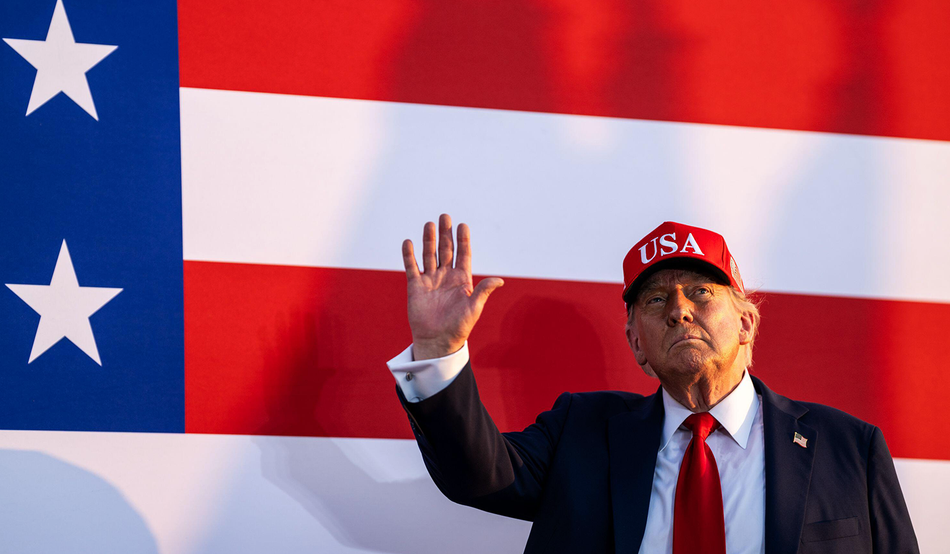Masked agents abducting lawful foreign residents into unmarked vans; unconstitutional deportations to El Salvador; the arrest of a Congresswoman conducting oversight of an immigration centre; university funding culled… these are surely not the actions of a democratic state.
So what type of state are they the actions of? From the pages of the Guardian to numerous expert seminars, commentators are queueing up to denounce the Trump administration as “fascist”. Former Yale philosophy professor Jason Stanley has relocated to Toronto, along with history professors Timothy Snyder and Marci Shore, in order to raise his children “in a country that is not tilting towards a fascist dictatorship”.
Richard Griffiths, a leading authority on the European right, once wrote that “‘Fascism’ is probably the most misused, and over-used, word of our times”. Historian Ian Kershaw, author of the definitive Hitler biography, admitted that “trying to define ‘fascism’ is like trying to nail jelly to the wall”. He nonetheless proceeded to identify common ideological features of the extreme right and, in a second step, to distinguish fascism from other right-wing, authoritarian movements. Describing the fascist states of the 20th century, he wrote:
They sought total commitment to the collective will of a united nation. They demanded soul as well as body. They looked to create a ‘new man’ (the language was invariably macho), a new society, a national utopia. This total claim, more than anything else, was ultimately what made fascism revolutionary and distinguished it from related parts of the Right that were authoritarian and nationalist but looked essentially to conserve the existing social order.
Fascism is a revolutionary and dynamic ideology because it seeks to sweep away the existing order and replace it with a new, totally unified nation. Fascist movements have a vision of how they want to reshape and reengineer, change and transform society; they pursue a comprehensive rebirth of the nation, freed from the shackles of the past, liberated to fulfil their historic destiny.
Yes, Trump and the Maga movement exhibit undeniable and pronounced authoritarian and anti-democratic tendencies. As an explanatory framework, however, fascism inadequately describes what’s happening in America.
Why? First, fascist movements tend to harness the power of the state to their own ends. In the words of Benito Mussolini, who developed the original fascist ideology in Italy: “Tutto nello Stato, niente al di fuori dello Stato, nulla contro lo Stato” (“Everything within the state, nothing outside the state, nothing against the state”). With few exceptions (such as federal law enforcement), the Trump administration is instead dismantling state institutions in true American style—the concept of “small government”, taken, in this case, to its extreme. According to a recent CNN analysis, at least 121,000 federal workers across more than 30 agencies were laid off or targeted for layoffs in the first 100 days of President Trump’s second term. The National Institutes of Health, the Department of Education, the Department of Housing, the Agency for International Development, the Internal Revenue Service and the Department of Defense are just some of the agencies whose workforce has been slashed.
Second, fascist movements have a vision of how they want to reshape and reengineer society. While the Trump administration is already adopting policies that target both legal and illegal immigrants, dissidents, the homeless, the press, universities and independent agencies, it does not appear to have a vision beyond its pursuit of a radical form of libertarianism motivated by self-interest, opportunism and an appetite for revenge. Instead of massively expanding the capacity of the state as a whole to achieve a reimagined, utopian society, Trump relies entirely upon the instrument of executive orders—easily challenged or reversed by an act of Congress. His vision, such as it is, appears incoherent—as exemplified by the push and pull between Elon Musk and Steve Bannon in the early days of this second term, not least over immigration. Instead of arbitrating between rivals within his orbit, Trump appears content to dwell on the results of the 2020 election and blame anything and everything on the Biden administration. This is not fascism, it is a free for all.
The Trump administration appears to be motivated by self-interest, opportunism and revenge
When it comes to US history and the legacy of small government, it is important to trace the beneficiaries of the devolution of power. Scepticism toward centralised authority is foundational to US political culture. The Articles of Confederation, ratified in 1781, created a very weak federal government; states retained most of the power. The Constitution of the United States, ratified seven years later, then only modestly vested authority in the executive branch, with most powers remaining in the bicameral Congress. With Virginians providing four of the first five presidents, the interests of the slave-owning class were well represented. Articulating the case for decentralised power, John C Calhoun, vice president under John Adams and Andrew Jackson, declared in 1849: “I never use the word nation in speaking of the United States. We are not a nation but a union, a confederacy of equal and sovereign States.”
The Civil War manifested the military solution to an irreconcilable political dispute. States’ rights advocates in the Confederacy sought to localise power to the state legislatures to perpetuate the institution of chattel slavery. The beneficiaries were the ruling gentry of the southern plantations, but power flowed into their own elected institutions. From the very beginning of the American republican experiment, democratic means were used in service of authoritarian ends. There were periods when government was centralised during the 20th century, but these were during times of national crisis, such as the Great Depression or the Second World War, and they proved to be the exception to the rule.
Anti-government policy found its clearest expression under President Ronald Reagan, epitomised in his famous line, “The nine most terrifying words in the English language are: I’m from the government and I’m here to help.” Grover Norquist, the conservative founder of Americans for Tax Reform in 1985, further refined this tenant of Reaganism by asserting that government shouldn’t be abolished, but should be so reduced in capacity that it would be possible to “drown it in the bathtub”. In a new interpretation, Reagan championed the privatisation of government services and the reduction of the regulatory scope of the state. In this case, the state’s resources were utilised to inject capital into financial markets and systematically empower the investor class.
Trump’s quest to reduce the power of the central government, by contrast, deviates from this American political tradition in one crucial way. His methods of disassembling the state are extractionist and kleptocratic, yet, in this instance, himself and select few accomplices are the beneficiaries. Unlike at the time of the Civil War, Trump is not decentralising power to privilege the states. Nor is he privatising core government agencies to benefit Wall Street. As his conflict with Walmart CEO Doug McMillon exemplifies, Trump’s tariff policies actually speak to a grand misalignment between the priorities of corporate America and Maga.
Other commentators, including Trump himself, categorise his brand of politics as “libertarian”. If libertarianism is “the belief that people should be free to think and behave as they want and should not have limits put on them by governments”, then Trump’s application of this credo is selective. At his second inauguration, he promised to “immediately stop all government censorship and bring back free speech to America”. In the words of Reporters Without Borders, however, “Trump’s second term as president has brought a troubling deterioration in press freedom”. He is a president who thinks he is above the law, undermines electoral integrity, weakens the legislative and judicial branches of government and rules by executive order (170 signed so far in his second term)—for himself and for select members of his oligarchy.
He is a president who rules for himself and for select members of his oligarchy
Trump is not attempting to capture by direct seizure the other two branches of government, the judiciary and the legislature. Yes, the Supreme Court’s membership is bent heavily in his favour. The correlation of power in Congress, on the other hand, is highly fragile, with the Republicans enjoying only a five-seat majority in the House of Representatives and a three-seat advantage in the Senate. Trump’s moves to strangle the federal government in the proverbial bathtub have not elicited sustained critique from Congress. This can still happen, however, as Congress remains an alternative (and competing) centre of power.
If Trump’s impulses are authoritarian, it is Congress’s disinclination to act that permits those impulses to go unchecked. Unlike in the case of the Enabling Act of 1933 in Germany, a law that granted the cabinet the power to pass laws without the involvement of the Reichstag, Congress still retains its constitutional power. The means to impeach this president remain. The Heritage Foundation’s Project 2025 has certainly set off alarm bells, as it aims to consolidate executive power, dismantle the federal bureaucracy and promote conservative values in numerous American institutions. Jason Stanley and Timothy Snyder have both drawn parallels between Project 2025 and historical fascist agendas. However, this agenda has yet to be anchored in legislation, thus preventing it—so far—from having an enduring impact beyond Trump’s current term in office.
“Everything within the state, nothing outside the state, nothing against the state.” The Trump administration is not fascist, but merely American political traditions taken to their logical extreme. This time, however, it is not the states (or the nation, however defined) that are the beneficiaries—but an oligarchy of extremely wealthy individuals.













